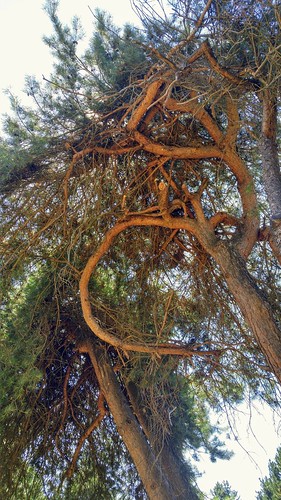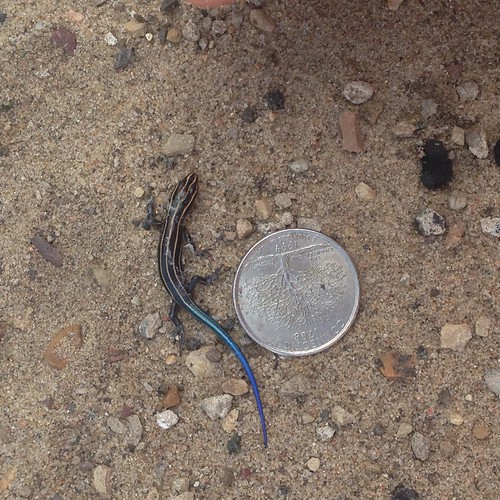Ithin the Yip1A TM domain are essential for the ER structuring function of Yip1A. (A) Quantification of cells that were co-transfected with the indicated HA-Yip1A mutated constructs and Yip1A siRNA. Data were from 3 independent experiments (.100 cells 22948146 per experiment), 6SD. Yellow bars indicate mutations that resulted in a partial rescue. (B, C) Cells co-transfected with Yip1A siRNA and HA-Yip1A K146E and V152L single or double mutant variant constructs were fixed after 72 h and co-stained with HA (B) and calnexin (C) antibodies. Double asterisks indicate cells expressing the double mutant variant that Autophagy exhibited ER whorls. Scale bar, 10 mm. (D) Quantification of the efficiency of rescue for (B) and (C) from three independent experiments (.100 cells per experiment) 6SD. Single asterisk, p#0.02 and double asterisk, p,0.0001. doi:10.1371/journal.pone.0054413.gand Methods), with 1 representing full rescue as exhibited by wild type Yip1A and 0 representing non-rescue as exhibited by the negative control Myc-Sec61b. Quantification in this manner revealed that neither HA-Yip1AN/Sec61bTM (Fig. 1D, E; quantified in J) nor HA-Yip1A D1-118 (Fig. 1G, H; quantified in J) could rescue the ER whorl phenotype; indeed both were indistinguishable from the negative control. Thus Yip1A depends on both its cytoplasmic and TM domains for function.Of note, HA-Yip1AN/Sec61bTM, Epigenetic Reader Domain lacking the entire Yip1A TM domain, seemed to exhibit less overlap with the ER marker calnexin than did full-length HA-Yip1A (compare Fig. 1D, E to Fig. 1A, B). Conversely, HA-Yip1A lacking its entire cytoplasmic domain seemed to have greater overlap with calnexin (compare Fig. 1G, H to Fig. 1A, B). These differences likely reflected a shift in the steady state distribution of each deletion variant with respect to full-length HA-Yip1A. That is, deletion of the Yip1A TM domain appeared to dispose the chimeric protein more towardsMutational Analysis of Yip1AFigure 5. Yif1A knockdown does not result in a whorled ER phenotype. HeLa cells transfected with either a negative control siRNA (A and B) or siRNA against Yif1A (C and D) were fixed after 72 h and costained with antibodies against GPP130 (A and C) and PDI (B and D). (E) HeLa cells cotransfected with mycYif1A and either a control siRNA or Yif1A siRNA, were harvested after 72 h and then immunoblotted using antibodies against tubulin and the myc-epitope. doi:10.1371/journal.pone.0054413.gpost-ER compartments; while deletion of the cytoplasmic domain appeared to dispose the truncated protein more towards the ER. This raised a caveat that the inability of HA-Yip1AN/Sec61bTM to control ER whorl formation might not be due to loss of a determinant required for regulating whorl formation, per se; but rather, to its sequestration from whorl forming membranes. Importantly though, subsequent detailed mapping of functional determinants within the TM domain indicated that Yip1A does indeed depend on residues within its TM domain for regulating whorl formation (see below). Thus the apparent lack of ER structuring activity by HA-Yip1AN/Sec61bTM  likely reflects a required role for the Yip1A TM domain in regulating ER whorl formation.Only a few key residues comprising a single site in the cytoplasmic domain are requiredGiven that the cytoplasmic and TM domains of Yip1A both appeared to be required for function, we sought to define the necessary elements in each half, starting with the cytoplasmic domain. We previously showed that a conserved Glu residue.Ithin the Yip1A TM domain are essential for the ER structuring function of Yip1A. (A) Quantification of cells that were co-transfected with the indicated HA-Yip1A mutated constructs and Yip1A siRNA. Data were from 3 independent experiments (.100 cells 22948146 per experiment), 6SD. Yellow bars indicate mutations that
likely reflects a required role for the Yip1A TM domain in regulating ER whorl formation.Only a few key residues comprising a single site in the cytoplasmic domain are requiredGiven that the cytoplasmic and TM domains of Yip1A both appeared to be required for function, we sought to define the necessary elements in each half, starting with the cytoplasmic domain. We previously showed that a conserved Glu residue.Ithin the Yip1A TM domain are essential for the ER structuring function of Yip1A. (A) Quantification of cells that were co-transfected with the indicated HA-Yip1A mutated constructs and Yip1A siRNA. Data were from 3 independent experiments (.100 cells 22948146 per experiment), 6SD. Yellow bars indicate mutations that  resulted in a partial rescue. (B, C) Cells co-transfected with Yip1A siRNA and HA-Yip1A K146E and V152L single or double mutant variant constructs were fixed after 72 h and co-stained with HA (B) and calnexin (C) antibodies. Double asterisks indicate cells expressing the double mutant variant that exhibited ER whorls. Scale bar, 10 mm. (D) Quantification of the efficiency of rescue for (B) and (C) from three independent experiments (.100 cells per experiment) 6SD. Single asterisk, p#0.02 and double asterisk, p,0.0001. doi:10.1371/journal.pone.0054413.gand Methods), with 1 representing full rescue as exhibited by wild type Yip1A and 0 representing non-rescue as exhibited by the negative control Myc-Sec61b. Quantification in this manner revealed that neither HA-Yip1AN/Sec61bTM (Fig. 1D, E; quantified in J) nor HA-Yip1A D1-118 (Fig. 1G, H; quantified in J) could rescue the ER whorl phenotype; indeed both were indistinguishable from the negative control. Thus Yip1A depends on both its cytoplasmic and TM domains for function.Of note, HA-Yip1AN/Sec61bTM, lacking the entire Yip1A TM domain, seemed to exhibit less overlap with the ER marker calnexin than did full-length HA-Yip1A (compare Fig. 1D, E to Fig. 1A, B). Conversely, HA-Yip1A lacking its entire cytoplasmic domain seemed to have greater overlap with calnexin (compare Fig. 1G, H to Fig. 1A, B). These differences likely reflected a shift in the steady state distribution of each deletion variant with respect to full-length HA-Yip1A. That is, deletion of the Yip1A TM domain appeared to dispose the chimeric protein more towardsMutational Analysis of Yip1AFigure 5. Yif1A knockdown does not result in a whorled ER phenotype. HeLa cells transfected with either a negative control siRNA (A and B) or siRNA against Yif1A (C and D) were fixed after 72 h and costained with antibodies against GPP130 (A and C) and PDI (B and D). (E) HeLa cells cotransfected with mycYif1A and either a control siRNA or Yif1A siRNA, were harvested after 72 h and then immunoblotted using antibodies against tubulin and the myc-epitope. doi:10.1371/journal.pone.0054413.gpost-ER compartments; while deletion of the cytoplasmic domain appeared to dispose the truncated protein more towards the ER. This raised a caveat that the inability of HA-Yip1AN/Sec61bTM to control ER whorl formation might not be due to loss of a determinant required for regulating whorl formation, per se; but rather, to its sequestration from whorl forming membranes. Importantly though, subsequent detailed mapping of functional determinants within the TM domain indicated that Yip1A does indeed depend on residues within its TM domain for regulating whorl formation (see below). Thus the apparent lack of ER structuring activity by HA-Yip1AN/Sec61bTM likely reflects a required role for the Yip1A TM domain in regulating ER whorl formation.Only a few key residues comprising a single site in the cytoplasmic domain are requiredGiven that the cytoplasmic and TM domains of Yip1A both appeared to be required for function, we sought to define the necessary elements in each half, starting with the cytoplasmic domain. We previously showed that a conserved Glu residue.
resulted in a partial rescue. (B, C) Cells co-transfected with Yip1A siRNA and HA-Yip1A K146E and V152L single or double mutant variant constructs were fixed after 72 h and co-stained with HA (B) and calnexin (C) antibodies. Double asterisks indicate cells expressing the double mutant variant that exhibited ER whorls. Scale bar, 10 mm. (D) Quantification of the efficiency of rescue for (B) and (C) from three independent experiments (.100 cells per experiment) 6SD. Single asterisk, p#0.02 and double asterisk, p,0.0001. doi:10.1371/journal.pone.0054413.gand Methods), with 1 representing full rescue as exhibited by wild type Yip1A and 0 representing non-rescue as exhibited by the negative control Myc-Sec61b. Quantification in this manner revealed that neither HA-Yip1AN/Sec61bTM (Fig. 1D, E; quantified in J) nor HA-Yip1A D1-118 (Fig. 1G, H; quantified in J) could rescue the ER whorl phenotype; indeed both were indistinguishable from the negative control. Thus Yip1A depends on both its cytoplasmic and TM domains for function.Of note, HA-Yip1AN/Sec61bTM, lacking the entire Yip1A TM domain, seemed to exhibit less overlap with the ER marker calnexin than did full-length HA-Yip1A (compare Fig. 1D, E to Fig. 1A, B). Conversely, HA-Yip1A lacking its entire cytoplasmic domain seemed to have greater overlap with calnexin (compare Fig. 1G, H to Fig. 1A, B). These differences likely reflected a shift in the steady state distribution of each deletion variant with respect to full-length HA-Yip1A. That is, deletion of the Yip1A TM domain appeared to dispose the chimeric protein more towardsMutational Analysis of Yip1AFigure 5. Yif1A knockdown does not result in a whorled ER phenotype. HeLa cells transfected with either a negative control siRNA (A and B) or siRNA against Yif1A (C and D) were fixed after 72 h and costained with antibodies against GPP130 (A and C) and PDI (B and D). (E) HeLa cells cotransfected with mycYif1A and either a control siRNA or Yif1A siRNA, were harvested after 72 h and then immunoblotted using antibodies against tubulin and the myc-epitope. doi:10.1371/journal.pone.0054413.gpost-ER compartments; while deletion of the cytoplasmic domain appeared to dispose the truncated protein more towards the ER. This raised a caveat that the inability of HA-Yip1AN/Sec61bTM to control ER whorl formation might not be due to loss of a determinant required for regulating whorl formation, per se; but rather, to its sequestration from whorl forming membranes. Importantly though, subsequent detailed mapping of functional determinants within the TM domain indicated that Yip1A does indeed depend on residues within its TM domain for regulating whorl formation (see below). Thus the apparent lack of ER structuring activity by HA-Yip1AN/Sec61bTM likely reflects a required role for the Yip1A TM domain in regulating ER whorl formation.Only a few key residues comprising a single site in the cytoplasmic domain are requiredGiven that the cytoplasmic and TM domains of Yip1A both appeared to be required for function, we sought to define the necessary elements in each half, starting with the cytoplasmic domain. We previously showed that a conserved Glu residue.
HIV gp120-CD4 gp120-cd4.com
Just another WordPress site
